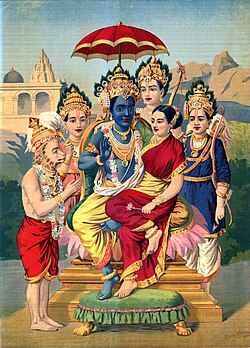Kusha (Ramayana)
 From Wikipedia - Reading time: 7 min
From Wikipedia - Reading time: 7 min
| Kusha | |
|---|---|
| Prince of Ayodhya King of Kasur | |
 | |
| Spouse | Kumudvatī (referred as Champika in Ananda Ramayana) |
| Dynasty | Raghuvamsha-Suryavamsha |
| Father | Rama |
| Mother | Sita |
Kusha (Sanskrit: कुश, IAST: Kuśa) and his younger twin brother Lava were the children of Rama and Sita.[1] Their story is recounted in the Hindu epic, the Ramayana. Hindu traditions claim he ruled the entire region of Kashmir, Indus River and Hindu Kush as frontier lands of India known as Hindu Kush Kshetra and founded the city of Srinagar in the Kashmir Valley and Kasur with Lavapuri of Lava in base lands,[2] though local lore contends Kasur was founded in 1525 by Pashtun migrants.[3][4][5] His brother Lava is traditionally believed to have founded Lavapuri (current day city of Lahore).
The imperial line that ruled Kingdom of Benares-Kashi and the Maurya Empire, which ruled South Asia from 320 to 185 BCE, claimed descent from Kusha. Kusha is said to be a Raghuvamshi Ikshvaku Suryavanshi. He got two children from his wife Kumudvati: Athithi (son) and Kanikamalika (daughter, wife of Yadava descent king Mahabhoja).
Birth and childhood
[edit]

According to the Ramayana, a pregnant queen Sita is made to leave the kingdom of Ayodhya by the King, Lord Rama, in order to demonstrate that no one is above Dharma and also to refute the allegation against her by a citizen of his kingdom. She then took refuge in the ashram of the sage Valmiki located close to the Triveni Dham where the Tamasa, Sona and Sapta Gandaki rivers meet, located in Chitwan District of Nepal's Tamsa River.[6] Sita gave birth to twin sons, Kusha and Lava, at the ashram, where they were educated and trained in military skills under the tutelage of Sage Valmiki. They also learned the story of Rama.
Ashwamedha Yajna
[edit]
Sage Valmiki, along with Lava and Kusha and a disguised Sita, attend an ashvamedha yajna held by Rama.
Lava and Kusha chanted the Ramayana in the presence of Rama and a vast audience. When Lava and Kusha recited about Sita's exile, Rama became grief-stricken and Valmiki produced Sita. Sita, struck with embarrassment and grief, called upon the earth, her mother (Bhūmi), to receive her and as the ground opened, she vanished into it. Rama then learnt that Lava and Kusha were his children.
In some versions, Lava and Kusha capture the horse of the sacrifice and defeat Rama's brothers and their army and when Rama came to fight with them. Sita intervened and unites the father and sons.
Legends
[edit]Kushavati was a city in Kosala Kingdom as related in the epic Ramayana. The king of Kosala, Rama, installed his son Lava at Shravasti and Kusha at Kushavati.
Cantos sixteen to nineteen of the Ānanda Rāmāyaṇa describe the exploits of Rama's progeny. The manifestation of a Goddess appears before Kusha, declaring to be the Tutelary deity of the ancient capital of Ayodhya. She described the condition of the deserted city, which had been abandoned and ruined since King Ram became inactive for some time. Kusha sets forth with his whole army to restore the city to its former splendor.
Canto seventeen describes the final years of Kusha. Kusha and Kumudvati have a son named Atithi, who becomes heir to the kingdom ; Cantos eighteen and nineteen describe the 21 Kings that succeeded Atithi.
Later history
[edit]Lava and Kusha became rulers after their father Rama and founded the cities of Lavapuri (modern day Lahore) and Kusha (Kasur) respectively.
Kushavati was a city in Kosala Kingdom as related in the epic Ramayana. The king of Kosala, Rama, installed his son Lava at Shravasti and Kusha at Kushavati.
References
[edit]- ^ Mani, Chandra Mauli (2009). Memorable Characters from the Rāmāyaṇa and the Mahābhārata. Northern Book Centre. p. 77. ISBN 978-81-7211-257-8.
- ^ Nadiem, Ihsan N (2005). Punjab. Al-Faisal Nashran. p. 111. ISBN 9789695034347.
- ^ Chopra, Gulshan Lall (1940). Chiefs and Families of Note in the Punjab. Government Printing.
- ^ Sikand, Yoginder (19 July 2011). Beyond The Border: An Indian in Pakistan. Penguin UK. ISBN 9789352141326.
- ^ Nadiem, Ihsan H. (2005). Punjab: land, history, people. al-Faisal Nashran. ISBN 9789695032831.
- ^ Vishvanath Limaye (1984). Historic Rama of Valmiki. Gyan Ganga Prakashan.
 KSF
KSF